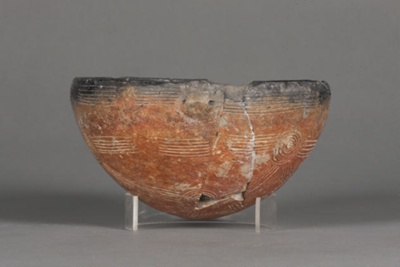< Collection search
< Collection highlights
From:UC Teece Museum of Classical Antiquities
Name/TitleBowl
About this objectThis Bronze Age knob lug bowl was found in a pit-tomb near Nicosia in Cyprus. It is a hemispherical clay bowl that has been covered in an orange-red slip that has been fired black at the lip and on the inner surface. Line decoration has been incised on the outer surface. Around the lip are groups of six horizontal lines. On the body are concentric circles linked by groups of five lines. There tends to be two sets of line groups between each circle set. The underside has groups of fine lines arranged in two rows.
Vessels of this shape are often made by shaping around a gourd, another bowl or some other rounded object to give a regular shape. The knob lug is a small addition near the rim which acts as a handle or hanging point. The knob can be shaped around a stick or pierced to produce a hole used to hang the vessel. Knob-lug bowls were a common find in Bronze Age Cypriot sites. They were used as eating bowls, and hung away when not in use.
Date Made21st Century BC
PeriodEarly Cypriote
Place MadeCyprus
Place NotesExcavated from Ayia Paraskevi, tomb 11
Medium and MaterialsCeramic: Pottery
Style and IconographyCypriote
Style and IconographyRed polished II
Style and IconographyGeometric patterns
TechniqueMolding (forming)
TechniqueIncising
TechniqueGlazing (coating process)
TechniqueSlab method (pottery technique)
MeasurementsHeight ca. 80mm; Diameter ca. 150mm
Subject and Association KeywordsFood history
Subject and Association KeywordsMourning customs
Subject and Association KeywordsRepetition (aesthetics)
Named CollectionThe James Logie Memorial Collection, University of Canterbury, New Zealand
Credit LineDonated by the Melbourne University Cyprus Expedition, 1957.
Object TypeFood Service Vessels
Object number50.57
Copyright LicenceAll rights reserved


